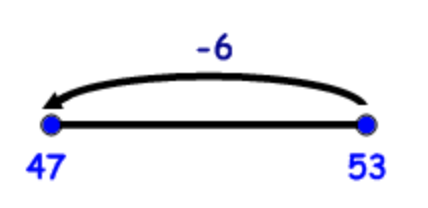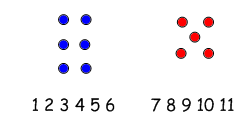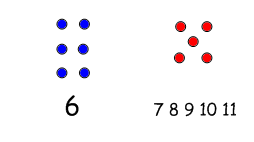|
Why do they do sums this way
instead of this way?
INTERESTING FACT: Children who are held back from learning the written methods for addition and subtraction, and are first encouraged to work things out mentally, become much more confident with numbers! With the written method you can make silly mistakes if you don’t think carefully.. Adding up the columns is fine with a sum like this… |
|
but doesn’t work so well with a sum like this one…
where you will often get mistakes like this!
What?? How do children get that? Simple! 4 and 3 makes 7. 5 and seven makes 12. Answer 712! And you get even more problems with subtraction. Because of this, many schools now put a strong emphasis in the early Primary School years on mental calculation skills and delay the teaching of traditional written methods until the children have a firm understanding of the number system.
Written Recording of Mental Calculations Even when you are learning to work things out in your head, it is still important to get into the habit of showing your working. So you need a way of writing things down. The horizontal recording
is designed to encourage a child to think about the calculation process: you can’t just add up the columns, because there aren’t any! So if your child’s school is teaching horizontal recording, they will be very happy if you do NOT try to show your child the traditional vertical method. It will come eventually. You just have to be patient!
How is the horizontal recording taught? Isn’t it much more difficult? The secret to all good teaching is building up from easy skills to harder ones step by step. Before learning to do calculations like the one above, your child will first have to become secure with simpler calculations. It works something like this: It sounds complicated at first, doesn’t it? But children who learn this way, and become secure at each step, become SO much more confident with manipulating numbers later on. The process works exactly the same way with subtraction, so many schools will teach the addition and subtraction process together, emphasising the links between the two. ( 12 – 5 = 7 because 7 + 5 = 12 etc) If you want to support the learning process at home, the games that follow will help your child at each of the different stages. |
|
Step 2: Adding and subtracting tens Once you are secure with the number bonds to ten, you can use these facts to help add and subtract larger numbers. 3 + 7 = 10 so 30 + 70 = 100 etc But first you need to be confident with the number sequence up to 100. A lot of early mathematical activities in school will involve counting or ordering the numbers. You can support these at home using equipment which is very easy to make.
The Counting Stick is a wonderfully versatile tool for making children comfortable with the order of any size of numbers. It is brilliant for learning the positions of all the numbers to 100 and for estimating. It is definitely worth making one of these. All you need is a strip of wood marked off into ten equal sections. A trip to your local hardware store for some 2 by 1 will do the trick nicely. If you get the piece cut to exactly 1m long, you can use it for measuring activities as well. |
|
There are several excellent activities you can play using a couple of metre sticks. Schools purchase these through catalogues, but you can easily make your own in the same way as a counting stick. Divide the stick into ten equal sections again and mark in the tens numbers 0, 10, 20 etc. Then put smaller marks to show the individual centimetres, but only write in the 5s numbers (ie write in 5, 15, 25, etc but not 1, 2, 3, 4, 6, 7, etc.
Two Hands One Piano is really good for consolidating the positions of all the numbers from 0 to 100.
Back to Back Metre Sticks is excellent for learning the pairs of numbers that add to make 100.
Metre Stick Jumps practises addition and subtraction of tens within 100. 40 + 30 = 70 80 – 20 = 60 etc
When you are ready to venture beyond 100, Wake Up Chum is a hilarious game which teaches the crucial skill of counting over from one hundred into the next and back again. 80, 90, 100, 110, 120 etc Again it is very easy to make. |
|
Step 3: Two-digit numbers plus or minus single digits When we are confident with these: 9 – 3 = 6 5 + 7 = 12 then alongside learning these: 90 – 30 = 60 50 + 70 = 120 we can learn how to do these. 47 + 6 = 53 53 – 6 = 47
The Maths programmes used in many schools support children’s mental addition and subtraction skills in three main ways:
|
|
Counting On and Counting Back Counting on and counting back work the same as they do with single-digit numbers. Example: 47 + 6 Think 47 and then count: 48, 49, 50, 51, 52, 53. Example: 53 – 6 Think 53 and then count backwards: 52, 51, 50, 49, 48, 47
Number Patterns Children’s understanding of how addition and subtraction work can be built up very effectively by exploring patterns. Example: 7 + 6 = 13 17 + 6 = 23 27 + 6 = 33 37 + 6 = 43 etc The exploration of number patterns is fully developed in the online patternbuilders.
The Blank Number Line An important part of becoming confident with Maths is learning to visualise the number line in your head. As a step on the way to this, you can draw a blank number line and use this to help with addition and subtraction. Here’s how it works. Example: 47 + 6
Example: 53 – 6
All of these ideas can be explored at home using the metre stick. No specific instructions are given here for this, since it is expected that you will want to leave the school to do this bit, but if you want to explore the ideas with your child at home, then read through the guidance for parents on Tips for Maths at Home. |
|
|
Step 4: Two-digit numbers plus or minus tens numbers When we are confident with these: 90 – 30 = 60 50 + 70 = 120 and these: 47 + 6 = 53 53 – 6 = 47 then we can learn how to do these. 47 + 30 = 77 77 – 30 = 47
We can use exactly the same techniques as with the last step.
|
|
Explore Number Patterns Example: 47 + 10 = 57 47 + 20 = 67 47 + 30 = 77 47 + 40 = 87 etc
The Blank Number Line Example: 47 + 30
Example: 77 – 30
Mental Counting On and Counting Back Example: 47 + 30 Think 47 and then count: 57, 67, 77. Example: 77 – 30 Think 77 and then count backwards: 67, 57, 47 |
|
Step 5: Two-digit numbers plus or minus two-digit numbers Finally, when we are confident with these: 47 + 6 = 53 53 – 6 = 47 and these: 47 + 30 = 77 77 – 30 = 47 then we can learn how to do these 47 + 36 = 83 83 – 36 = 47
Example: 47 + 36 |
|
Start with 47. First add the tens, then add the units:
47 + 30 = 77 77 + 6 = 83
Example: 83 – 36 Start with 83. First subtract the tens, then subtract the units:
83 – 30 = 53 53 – 6 = 47
Notice that when we do things mentally, the most natural way is to deal with the tens first (since they are the biggest thing) and then deal with the units. This is the opposite to when we do written ‘sums’ where we always do the units first. That’s it! Hopefully, having read this far you will now be much more confident in helping your child with adding and subtracting! |












